Dissimilar Joining of Aluminum to High-Melting-Point Alloys by Hot Dipping
Abstract
1. Introduction
2. Materials and Methods
2.1. Experimental Procedure
2.2. Mathematical Model
3. Results and Discussion
3.1. Forming of Joints and Macroscopic Morphology of the Cross-Section
3.2. Microstructure and Phase Identification of Joints
3.3. Mechanical Properties of Joints
3.4. Numerical Simulation Analysis
4. Conclusions
- (1)
- Metallurgical bonding between high-melting-point metals and aluminum is achieved at 670 °C for 5 s. The IMCs exhibit significant variations in morphology, thickness, and phase composition depending on the base materials. Specifically, the Al/Steel interface forms a single 5 μm thick Fe4Al13, while the Al/Ti interface develops a 1 μm thick TiAl3. In contrast, at the Al/Cu interface, the IMCs are composed of Al3Cu4 and Al2Cu, with a thickness exceeding 10 μm.
- (2)
- The Al/Cu joint demonstrates the highest shear strength (79.1 MPa), exceeding the Al/steel (42.9 MPa) and Al/Ti (37.2 MPa) joints. This strength difference correlates with the solid solution strengthening effect in the aluminum layer, governed by elemental diffusion. The fracture morphology indicates that the joints of Al/steel and Al/Ti exhibit a mixed mode of ductile and brittle fracture, whereas the joint of Al/Cu demonstrates a brittle fracture mode.
- (3)
- The solidification of molten aluminum on high-melting-point metals and subsequent dissimilar metal bonding relies on heat balance. During the hot-dipping process, heat transfer from the molten aluminum to the solid metals drives solidification. The solidified aluminum layer thickness varies with the thermal properties of the base metals. The higher thermal conductivity and specific heat capacity produce a thicker solidified aluminum layer on the surface of metals.
- (4)
- This novel approach is particularly well suited for large-scale bimetallic structures, offering excellent interface uniformity, and demonstrating significant potential for future applications.
Author Contributions
Funding
Institutional Review Board Statement
Informed Consent Statement
Data Availability Statement
Conflicts of Interest
References
- Xia, H.; Yang, B.; Han, Y.; Xu, L.; Tan, C.; Li, L.; Li, H.; Zhao, X.; Zhang, K. Toward Understanding the Fractured Mechanism in Laser Welded–Brazed Al/Steel Interface by in–Situ SEM Tensile Observations. J. Mater. Process. Technol. 2024, 325, 118294. [Google Scholar] [CrossRef]
- Lambiase, F.; Di Ilio, A. Joining Aluminum with Titanium Alloy Sheets by Mechanical Clinching. J. Manuf. Process. 2018, 35, 457–465. [Google Scholar] [CrossRef]
- Wang, P.Q.; Chen, D.L.; Ran, Y.; Yan, Y.Q.; She, X.W.; Peng, H.; Jiang, X.Q. Electromagnetic Pulse Welding of Al/Cu Dissimilar Materials: Microstructure and Tensile Properties. Mater. Sci. Eng. A 2020, 792, 139842. [Google Scholar] [CrossRef]
- He, H.; Gou, W.; Mendez, P.F.; Lin, S.; Yang, C. GTA Weld Brazing a Joint of Aluminum to Stainless Steel. Weld. J. 2019, 98, 365s–378s. [Google Scholar] [CrossRef]
- Hu, Y.; Chen, Y.; Li, L.; Hu, H.; Zhu, Z. Microstructure and Properties of Al/Cu Bimetal in Liquid–Solid Compound Casting. Process. Trans. Nonferrous Met. Soc. China 2016, 26, 1555–1563. [Google Scholar] [CrossRef]
- Zhang, Z.; Huang, J.; Fu, J.; Nie, P.; Zhang, S. Microstructure and Mechanical Properties of Laser Welded-Brazed Titanium/Aluminum Joints Assisted by Titanium Mesh Interlayer. J. Mater. Process. Technol. 2022, 302, 117502. [Google Scholar] [CrossRef]
- Lei, Z.; Li, P.; Zhang, X.; Wu, S.; Zhou, H.; Nannan, L. Microstructure and Mechanical Properties of Welding–Brazing of Ti/Al Butt Joints with Laser Melting Deposition Layer Additive. J. Manuf. Process. 2019, 38, 411–421. [Google Scholar] [CrossRef]
- Raoelison, R.N.; Buiron, N.; Rachik, M.; Haye, D.; Franz, G.; Habak, M. Study of the Elaboration of a Practical Weldability Window in Magnetic Pulse Welding. J. Mater. Process. Technol. 2013, 213, 1348–1354. [Google Scholar] [CrossRef]
- Shim, J.-Y.; Kim, I.-S. Selection of Design Parameters of Working Coil for Al/Cu Tubular Magnetic Pulse Welding. Adv. Mech. Eng. 2023, 15, 16878132231219573. [Google Scholar] [CrossRef]
- Taban, E.; Gould, J.E.; Lippold, J.C. Dissimilar Friction Welding of 6061-T6 Aluminum and AISI 1018 Steel: Properties and Microstructural Characterization. Mater. Des. 2010, 31, 2305–2311. [Google Scholar] [CrossRef]
- Yang, X.; Li, W.; Xu, Y.; Wen, Q.; Feng, W.; Wang, Y. Effect of Welding Speed on Microstructures and Mechanical Properties of Al/Cu Bimetal Composite Tubes by a Novel Friction-Based Welding Process. Weld. World 2019, 63, 127–136. [Google Scholar] [CrossRef]
- Senthil, S.M.; Bhuvanesh Kumar, M.; Dennison, M.S. A Contemporary Review on Friction Stir Welding of Circular Pipe Joints and the Influence of Fixtures on This Process. Adv. Mater. Sci. Eng. 2022, 2022, 122–130. [Google Scholar] [CrossRef]
- Wei, Y. Investigation of Interdiffusion and Intermetallic Compounds in Al–Cu Joint Produced by Continuous Drive Friction Welding. Eng. Sci. Technol. 2016, 19, 90–95. [Google Scholar] [CrossRef]
- Jiang, L.; Luo, N.; Liang, H.; Zhao, Y. Microstructure and Texture Distribution in the Bonding Interface of Cu/Al Composite Tube Fabricated by Explosive Welding. Int. J. Adv. Manuf. Technol. 2022, 123, 3021–3031. [Google Scholar] [CrossRef]
- Vajjala, S.; Singh, A.K.; Krishna, V.G.; Reddy, G.R. Vacuum Brazing of Dissimilar Tubular Component of AA2219 and AISI 304 by a Low Melting Al-18Ag-20Cu-5Si-0.2Zn Braze Alloy. J. Mater. Process. Technol. 2018, 252, 1–12. [Google Scholar]
- Sui, D.; Han, Q. Ultrasound-Assisted Cast-on Method: Obtaining High-Quality Metallurgical Bonds between a Bare Steel Insert and A354 Aluminum Alloy within a Composite Casting. J. Mater. Process. Technol. 2023, 311, 11778. [Google Scholar] [CrossRef]
- Han, Q. A Modified Cast-on Method for the Reinforcement of Aluminum Castings with Dissimilar Metals. Metall. Mater. Trans. B 2016, 47, 3266–3273. [Google Scholar] [CrossRef]
- Choi, J.-W.; Liu, H.; Fujii, H. Dissimilar Friction Stir Welding of Pure Ti and Pure Al. Mater. Sci. Eng. A 2018, 730, 168–176. [Google Scholar] [CrossRef]
- Chen, X.; Lei, Z.; Chen, Y.; Han, Y.; Jiang, M.; Tian, Z.; Bi, J.; Lin, S. Microstructure and Tensile Properties of Ti/Al Dissimilar Joint by Laser Welding-Brazing at Subatmospheric Pressure. J. Manuf. Process. 2020, 56, 19–27. [Google Scholar] [CrossRef]
- Pei, Y.; Huang, T.; Chen, F.; Pang, B.; Guo, J.; Xiang, N.; Song, Z.; Zhang, Y. Microstructure and Fracture Mechanism of Ti/Al Layered Composite Fabricated by Explosive Welding. Vacuum 2020, 181, 109596. [Google Scholar] [CrossRef]
- Liu, M.; Zhang, C.; Cheng, Z.; Liu, Z.; Chen, L.; Zhao, G. Micro-/Nano-Scale Interface Structure and Mechanical Characteristics of the Al/Ti Composite Bar Produced by a Novel Continuously-Extruded Technique. Mater. Des. 2023, 228, 111818. [Google Scholar] [CrossRef]
- Liu, M.; Zhang, C.; Liu, Z.; Meng, Z.; Yan, J.; Chen, L.; Zhao, G. Novel Interface Characteristics and Strengthening Mechanisms in Extruded Fiber(Ti)-Reinforced Al-Based Composites. J. Mater. Process. Technol. 2024, 325, 118304. [Google Scholar] [CrossRef]
- Zhou, H.; Shao, F.; Bai, L.; Yuan, J.; Xu, Q.; Liu, H. Interface Bonding and Mechanical Properties of Large Explosively Welded Titanium/Aluminum Composite Pipes. Intermetallics 2025, 176, 108476. [Google Scholar] [CrossRef]
- Li, C.; Zhang, T.; Liu, J.; Liu, Y. Synergistic Solid–Liquid Composite and Rapid Solidification Preparation of Aluminum-Clad Steel Wires. Mater. Des. 2024, 244, 113182. [Google Scholar] [CrossRef]
- He, H.; Zhang, L.; Liu, Z.; Zhao, W. Kinetics of Intermetallic Compound Layers between AISI 321 Stainless Steel and Molten Aluminum. Mater. Charact. 2023, 203, 113062. [Google Scholar] [CrossRef]
- Niu, S.; Wang, Z.; Lou, M.; Ma, Y.; Lei, H.; Li, Y. Resistance Rivet Welding of Aluminum/Titanium Dissimilar Materials. J. Manuf. Process. 2023, 108, 141–152. [Google Scholar] [CrossRef]
- Wang, H.; Wang, K.; Zheng, W. Microstructure Complexities of Laser Impact Welded Al-Ti Bonding Interface. Scr. Mater. 2022, 211, 11448. [Google Scholar] [CrossRef]
- Cao, F.; Zhang, P.; Zou, J.; Wang, T. The Formation and Growth of Intermetallic Compounds during Interdiffusion of Al/Cu Bimetals. Mater. Res. Express. 2022, 9, 056503. [Google Scholar] [CrossRef]
- He, H.; Gou, W.; Wang, S.; Hou, Y.; Ma, C.; Mendez, P.F. Kinetics of Intermetallic Compound Layers during Initial Period of Reaction between Mild Steel and Molten Aluminum. Int. J. Mater. Res. 2019, 110, 194–201. [Google Scholar] [CrossRef]
- Liu, M.; Zhang, C.; Meng, Z.; Zhao, G.; Chen, L. TiAl3 Nucleation Mechanism and Atomic-Scale Interface Features in the Al/Ti Composite Structures. Compos. Part B Eng. 2021, 226, 109331. [Google Scholar] [CrossRef]
- Guo, Y.; Liu, G.; Jin, H.; Shi, Z.; Qiao, G. Intermetallic Phase Formation in Diffusion-Bonded Cu/Al Laminates. J. Mater. Sci. 2011, 46, 2467–2473. [Google Scholar] [CrossRef]
- Chen, J.; Lai, Y.-S.; Wang, Y.-W.; Kao, C.R. Investigation of Growth Behavior of Al–Cu Intermetallic Compounds in Cu Wire Bonding. Microelectron. Reliab. 2011, 51, 125–129. [Google Scholar] [CrossRef]
- Tavassoli, S.; Abbasi, M.; Tahavvori, R. Controlling of IMCs Layers Formation Sequence, Bond Strength and Electrical Resistance in al Cu Bimetal Compound Casting Process. Mater. Des. 2016, 108, 343–353. [Google Scholar] [CrossRef]
- Lee, N.; Cahoon, J. Interdiffusion of Copper and Iron in Liquid Aluminum. J. Phase Equilib. Diffus. 2011, 32, 226–234. [Google Scholar] [CrossRef]
- Lee, S.-Y.; Taguchi, O.; Iijima, Y. Diffusion of Aluminum in Titanium. Mater. Trans. 2010, 51, 1809–1813. [Google Scholar] [CrossRef]
- Sun, T.; Geng, J.; Bian, Z.; Wu, Y.; Wang, M.; Chen, D.; Ma, N.; Wang, H. Enhanced Thermal Stability and Mechanical Properties of High-Temperature Resistant Al−Cu Alloy with Zr and Mn Micro-Alloying. Trans. Nonferrous Met. Soc. China 2022, 32, 64–78. [Google Scholar] [CrossRef]
- Sierra, G.; Peyre, P.; Beaume, F.D.; Stuart, D.; Fras, G. Steel to Aluminium Braze Welding by Laser Process with Al–12Si Filler Wire. Sci. Technol. Weld. Join. 2008, 13, 430–437. [Google Scholar] [CrossRef]
- Gao, L. Preparation and Toughness Mechanism of In-Situ Ti3AlC2 Enhanced and Toughened TiAl3 Matrix Composites. Intermetallics 2023, 161, 107963. [Google Scholar] [CrossRef]
- Kaya, Y. Investigation of Copper-Aluminium Composite Materials Produced by Explosive Welding. Metals 2018, 8, 780. [Google Scholar] [CrossRef]
- Potesser, M. The Characterization of the Intermetallic Fe-Al Layer of Steel-Aluminum Weldings. In Proceedings of the TMS Annual Meeting 2006, Atlanta, GA, USA, 12–17 October 2006; pp. 167–176. [Google Scholar]
- Chen, Y.; Wang, A.; Xie, J.; Guo, Y. Deformation Mechanisms in Al/Al2Cu/Cu Multilayer under Compressive Loading. J. Alloy. Compd. 2021, 885, 160921. [Google Scholar] [CrossRef]
- Zhou, S.; Peng, B.; Cao, Y.; Xu, Y.; Quan, G.; Ma, S.; Jiao, Z.; Luo, K. First-Principles Investigations on Stability, Elastic Properties and Electronic Structures of L12-TiAl3 and D022-TiAl3 under Pressure. Phys. B 2019, 571, 118–129. [Google Scholar] [CrossRef]
- Gulay, L.D.; Harbrecht, B. The Crystal Structure of ζ1-Al3Cu4. J. Alloys Compd. 2004, 367, 103–110. [Google Scholar] [CrossRef]
- Wang, Y.; Mendez, P.F. Isotherm Penetration Depth under a Moving Gaussian Surface Heat Source on a Thick Substrate. Int. J. Therm. Sci. 2022, 172, 107334. [Google Scholar] [CrossRef]
- Wang, Y.; Lu, Y.; Mendez, P.F. Scaling Expressions of Characteristic Values for a Moving Point Heat Source in Steady State on a Semi-Infinite Solid. Int. J. Heat Mass Transf. 2019, 135, 1118–1129. [Google Scholar] [CrossRef]
- Kim, D.-H.; Lee, C.-M. Experimental Investigation on Machinability of Titanium Alloy by Laser-Assisted End Milling. Metals 2021, 11, 1552. [Google Scholar] [CrossRef]
- Zhao, W.; Zhu, Y.; Liu, Z.; Fu, A.; He, H. Mechanism of Ultrasonic Effects on Thermal-Stress Field in Cu/Al-FSW Process. Int. J. Mech. Sci. 2024, 270, 109101. [Google Scholar] [CrossRef]
- Wang, H.; Qin, G.; Li, C. Effect of Different Friction Coefficient Models on Numerical Simulation of Inertia Friction Welding of 2219 Al Alloy to 304 Stainless Steel. J. Mater. Res. Technol. 2023, 27, 6474–6483. [Google Scholar] [CrossRef]
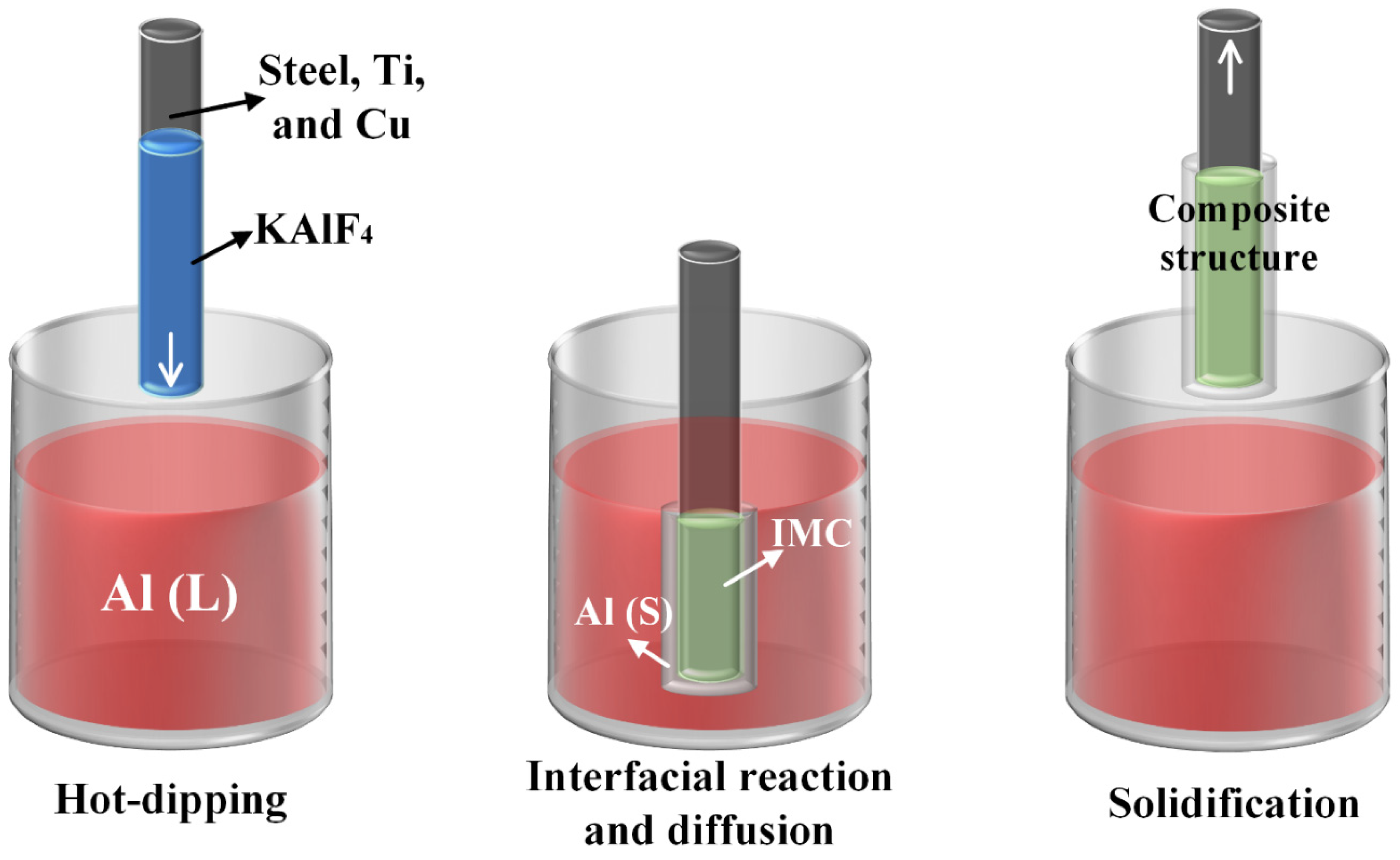
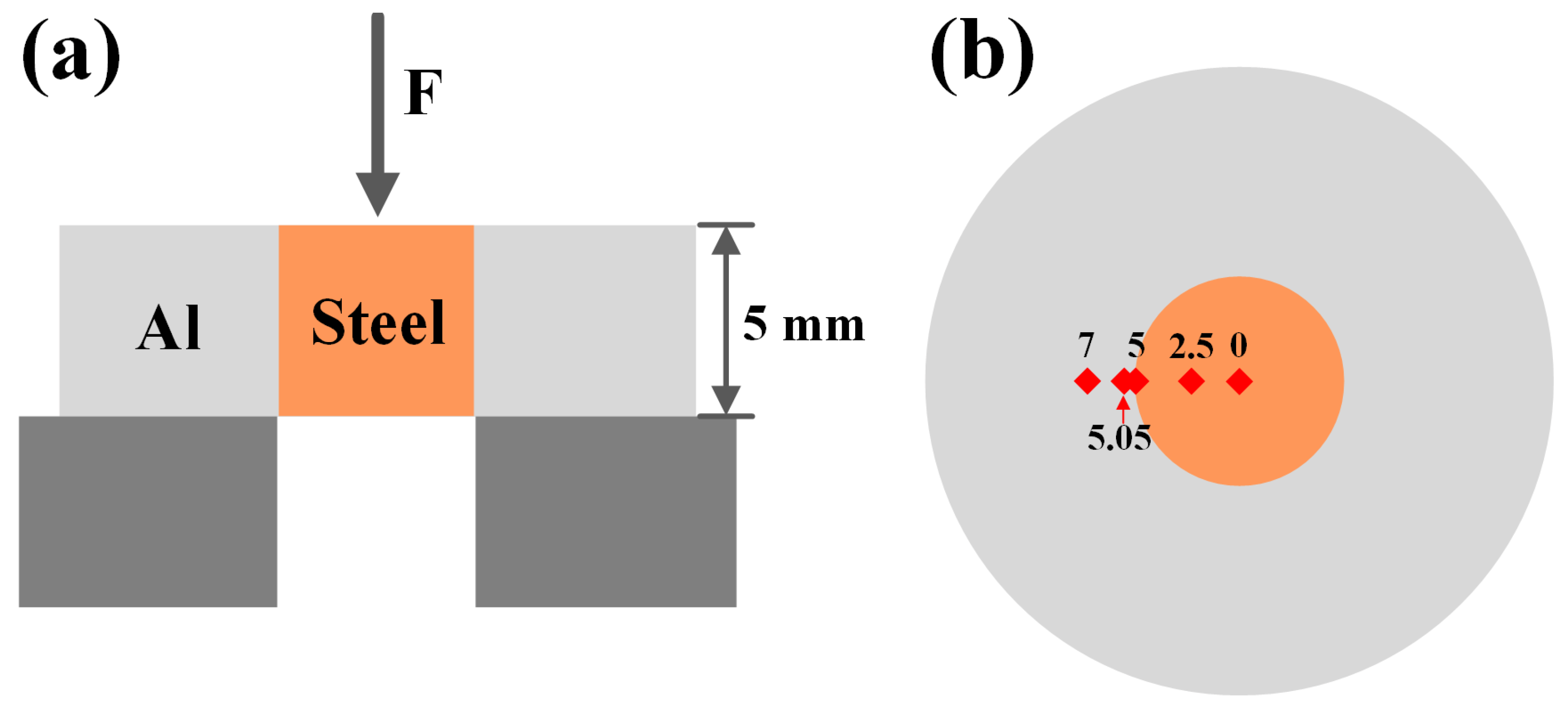

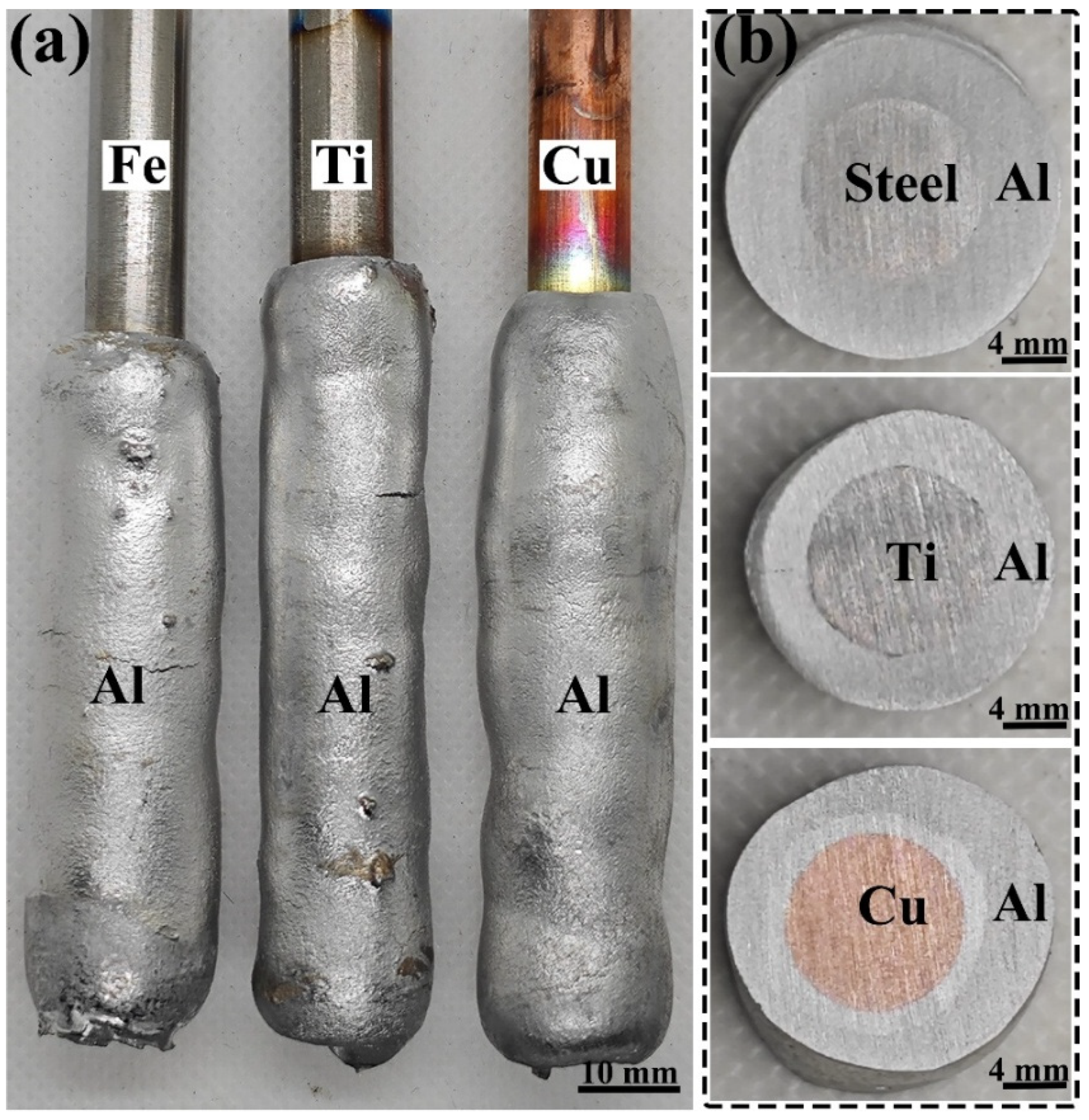
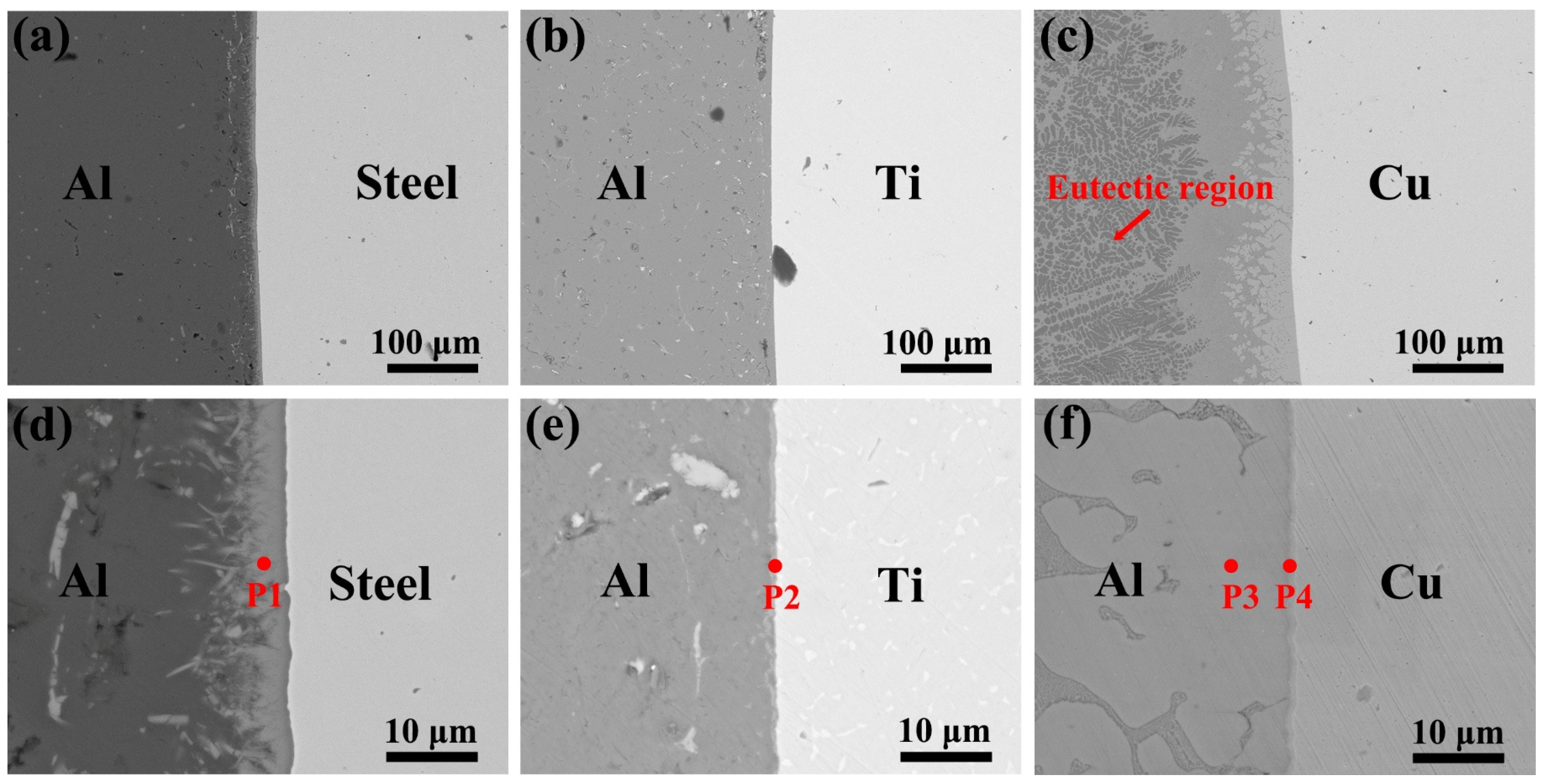
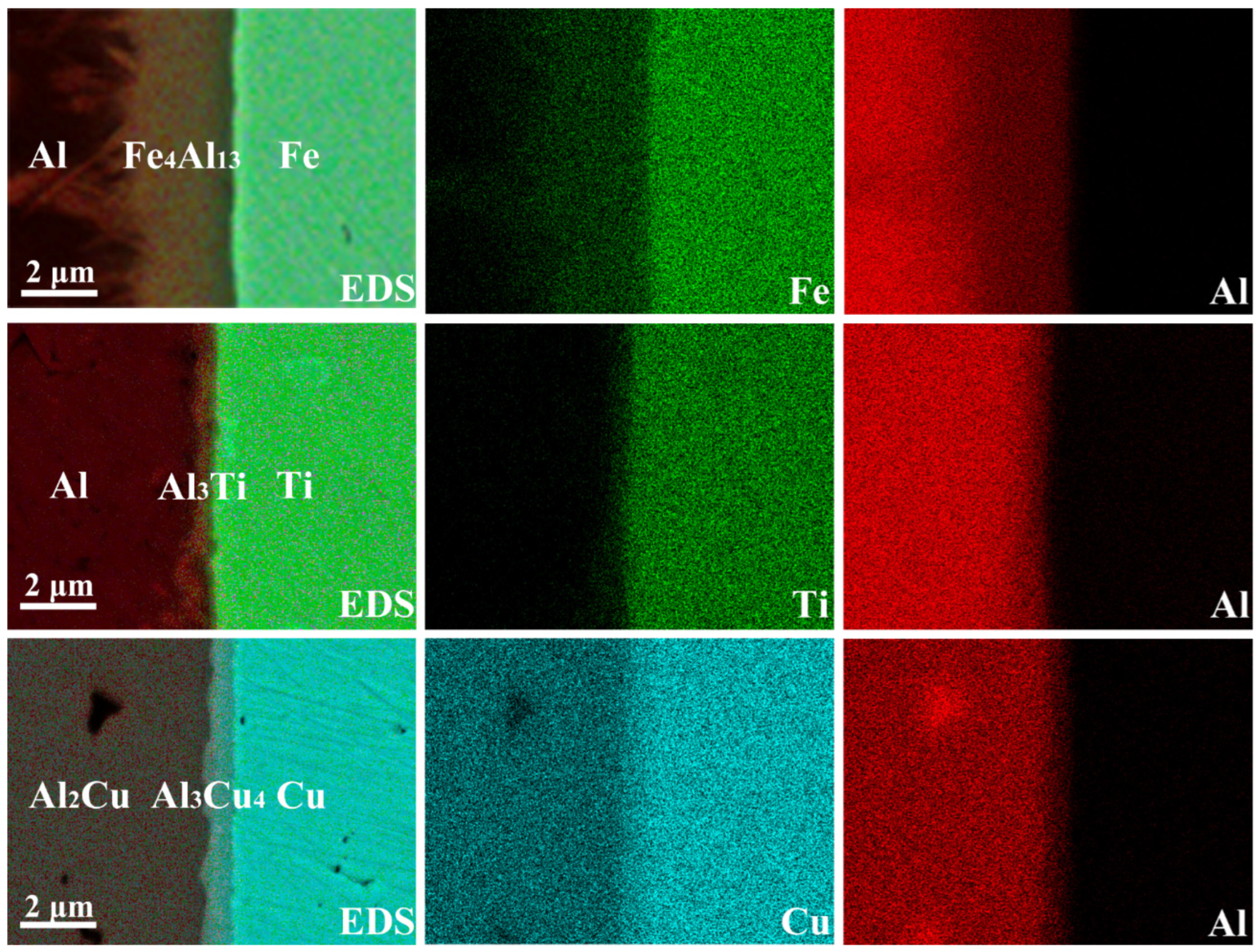
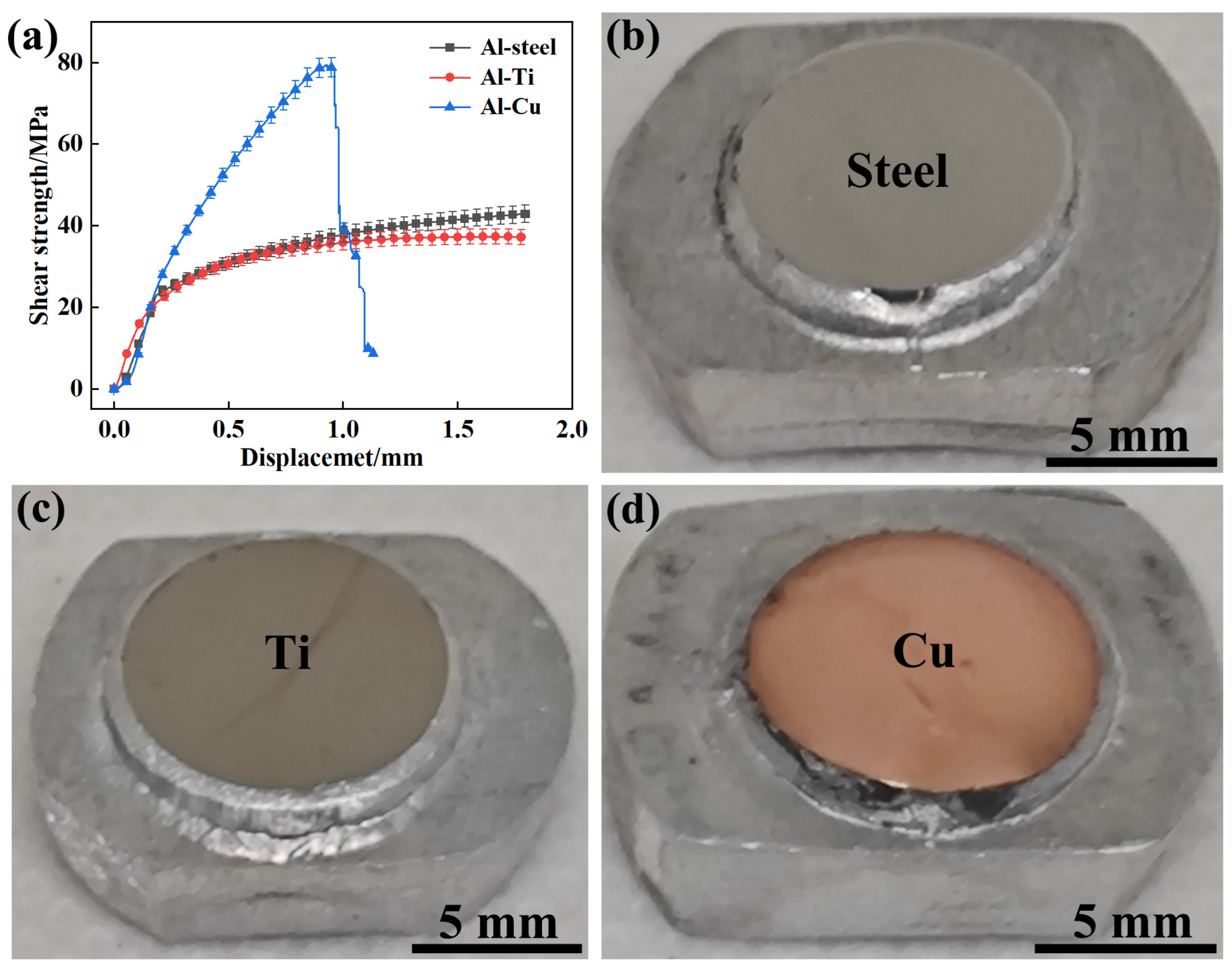
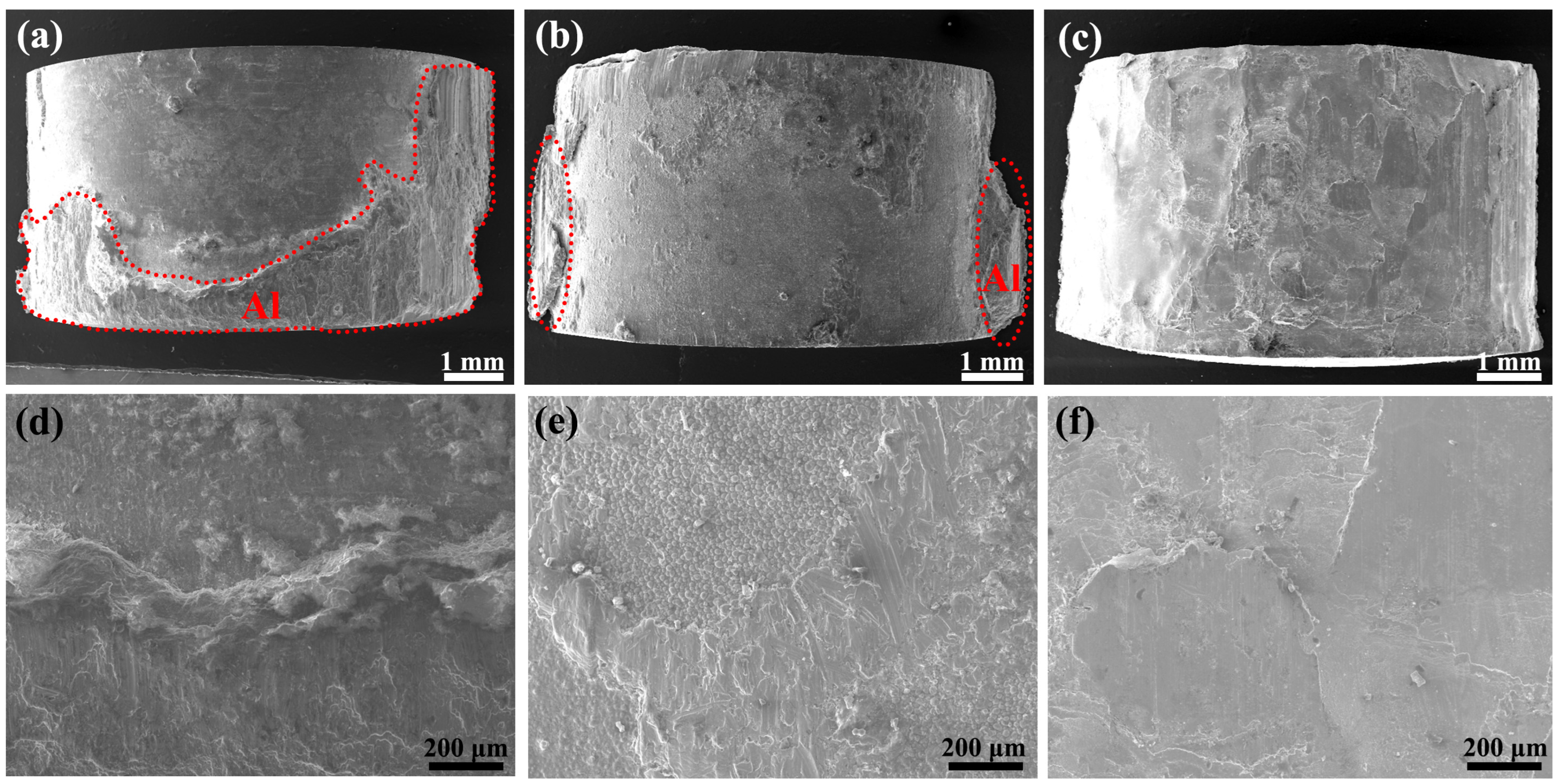
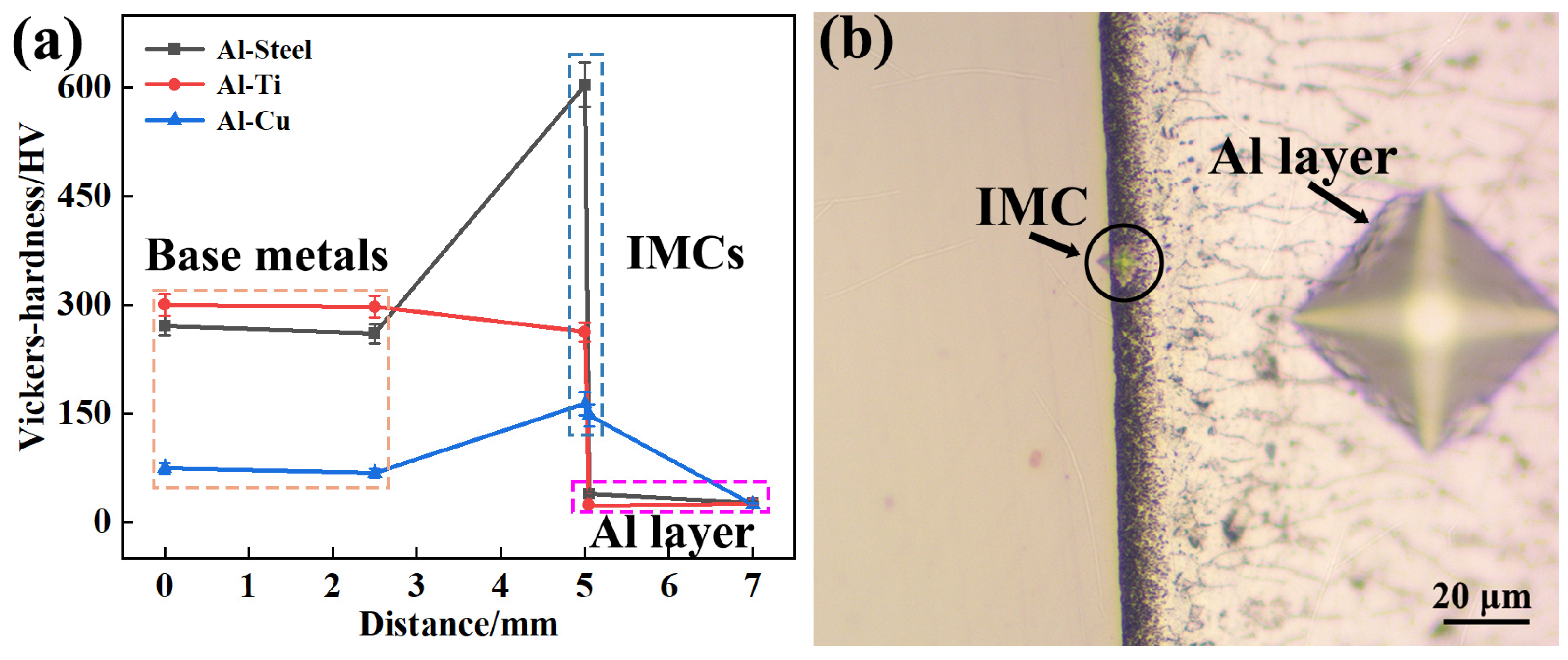
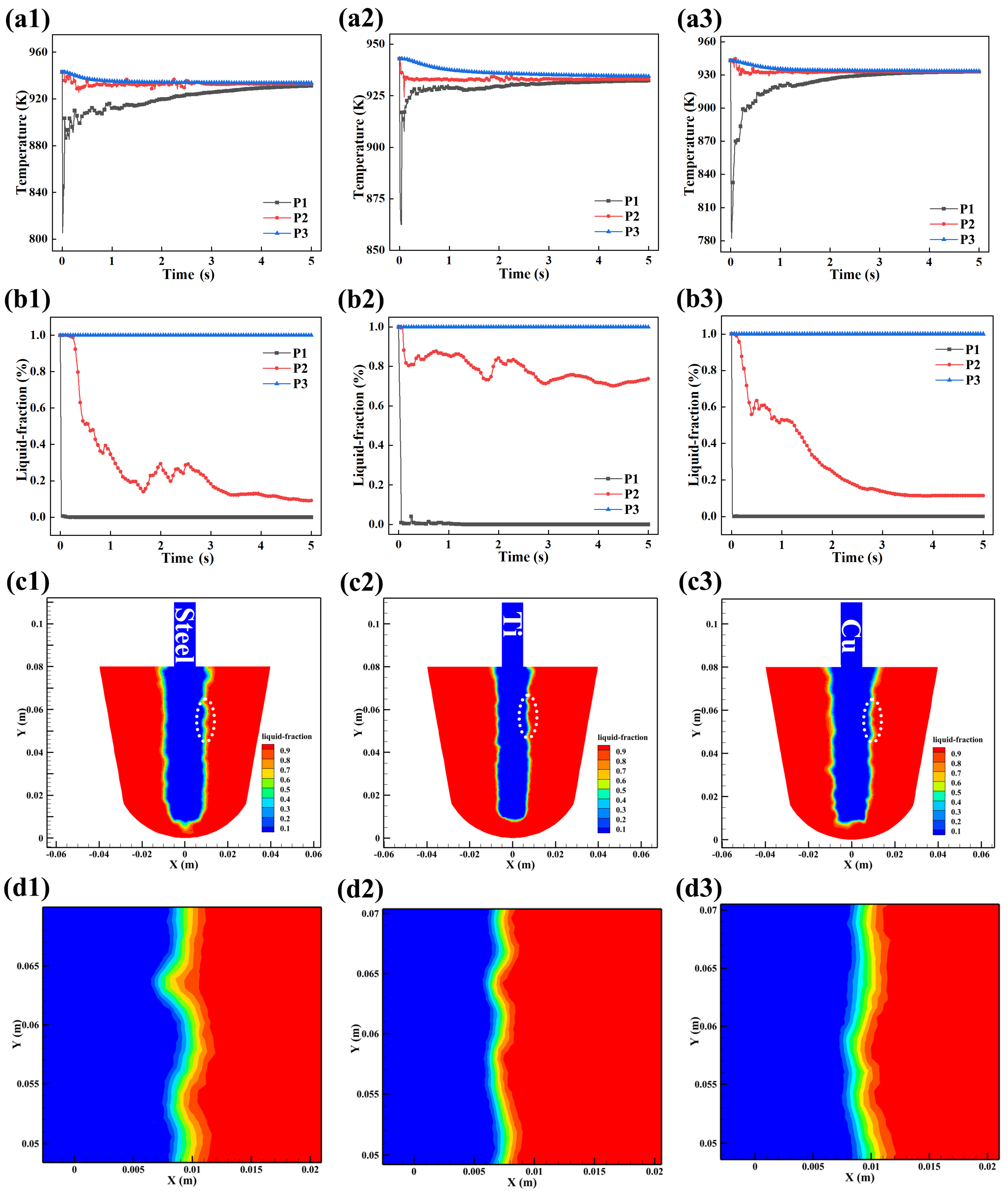
| Mn | C | Al | Mg | V | Si | Cu | Zn | Ti | Fe | Ni | Cr | |
|---|---|---|---|---|---|---|---|---|---|---|---|---|
| AISI 321 | 2 | 0.12 | - | - | - | 1 | - | - | 0.2 | Bal. | 8–10 | 17–19 |
| TC4 | - | 0.1 | 6 | - | 4 | - | - | - | Bal. | 0.3 | - | - |
| T2 | - | - | - | - | - | - | Bal. | - | - | 0.015 | - | - |
| 1050 | 0.05 | - | Bal. | 0.05 | 0.05 | 0.25 | 0.05 | 0.05 | 0.03 | 0.04 | - | - |
| Fe | Al | Cu | Ti | IMC | |
|---|---|---|---|---|---|
| P1 | 22.5 ± 0.4 | 72.3 ± 0.5 | -- | -- | Fe4Al13 |
| P2 | -- | 75.9 ± 0.4 | -- | 22.1 ± 0.3 | TiAl3 |
| P3 | -- | 71.2 ± 0.3 | 27.5 ± 0.3 | -- | Al2Cu |
| P4 | -- | 44.4 ± 0.3 | 54.3 ± 0.4 | -- | Al3Cu4 |
Disclaimer/Publisher’s Note: The statements, opinions and data contained in all publications are solely those of the individual author(s) and contributor(s) and not of MDPI and/or the editor(s). MDPI and/or the editor(s) disclaim responsibility for any injury to people or property resulting from any ideas, methods, instructions or products referred to in the content. |
© 2025 by the authors. Licensee MDPI, Basel, Switzerland. This article is an open access article distributed under the terms and conditions of the Creative Commons Attribution (CC BY) license (https://creativecommons.org/licenses/by/4.0/).
Share and Cite
Liu, Z.; Su, Q.; Wang, P.; Zhao, W.; Fu, A.; He, H. Dissimilar Joining of Aluminum to High-Melting-Point Alloys by Hot Dipping. Coatings 2025, 15, 541. https://doi.org/10.3390/coatings15050541
Liu Z, Su Q, Wang P, Zhao W, Fu A, He H. Dissimilar Joining of Aluminum to High-Melting-Point Alloys by Hot Dipping. Coatings. 2025; 15(5):541. https://doi.org/10.3390/coatings15050541
Chicago/Turabian StyleLiu, Zhaoxian, Qingjia Su, Pu Wang, Wenzhen Zhao, Ao Fu, and Huan He. 2025. "Dissimilar Joining of Aluminum to High-Melting-Point Alloys by Hot Dipping" Coatings 15, no. 5: 541. https://doi.org/10.3390/coatings15050541
APA StyleLiu, Z., Su, Q., Wang, P., Zhao, W., Fu, A., & He, H. (2025). Dissimilar Joining of Aluminum to High-Melting-Point Alloys by Hot Dipping. Coatings, 15(5), 541. https://doi.org/10.3390/coatings15050541







